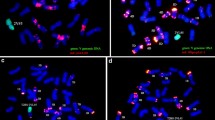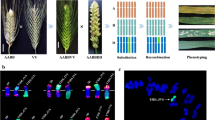Abstract
Key message
Powdery mildew resistance gene Pm55 was physically mapped to chromosome arm 5VS FL 0.60–0.80 of Dasypyrum villosum . Pm55 is present in T5VS·5AL and T5VS·5DL translocations, which should be valuable resources for wheat improvement.
Abstract
Powdery mildew caused by Blumeria graminis f. sp. tritici is a major wheat disease worldwide. Exploiting novel genes effective against powdery mildew from wild relatives of wheat is a promising strategy for controlling this disease. To identify novel resistance genes for powdery mildew from Dasypyrum villosum, a wild wheat relative, we evaluated a set of Chinese Spring-D. villosum disomic addition and whole-arm translocation lines for reactions to powdery mildew. Based on the evaluation data, we concluded that the D. villosum chromosome 5V controls post-seedling resistance to powdery mildew. Subsequently, three introgression lines were developed and confirmed by molecular and cytogenetic analysis following ionizing radiation of the pollen of a Chinese Spring-D. villosum 5V disomic addition line. A homozygous T5VS·5AL translocation line (NAU421) with good plant vigor and full fertility was further characterized using sequential genomic in situ hybridization, C-banding, and EST-STS marker analysis. A dominant gene permanently named Pm55 was located in chromosome bin 5VS 0.60–0.80 based on the responses to powdery mildew of all wheat-D. villosum 5V introgression lines evaluated at both seeding and adult stages. This study demonstrated that Pm55 conferred growth-stage and tissue-specific dependent resistance; therefore, it provides a novel resistance type for powdery mildew. The T5VS·5AL translocation line with additional softness loci Dina/Dinb of D. villosum provides a possibility of extending the range of grain textures to a super-soft category. Accordingly, this stock is a new source of resistance to powdery mildew and may be useful in both resistance mechanism studies and soft wheat improvement.




Similar content being viewed by others
References
Cao YP, Cao AZ, Wang XE, Chen PD (2009) Screening and application of EST-based PCR markers specific to individual chromosomes of Haynaldia villosa. Acta Agron Sin 35:1–10
Chen PD, Qi LL, Zhou B, Zhang SZ, Liu DJ (1995) Development and molecular cytogenetic analysis of wheat-Haynaldia villosa 6VS/6AL translocation lines specifying resistance to powdery mildew. Theor Appl Genet 91:1125–1128
Cromey MG (1989) Infection and control of stripe rust in wheat spikes. N Z J Crop Hortic Sci 17:159–164
De Pace C, Vaccino P, Cionini G, Pasquini M, Bizzarri M, Qualset CO (2011) Dasypyrum. In: Kole C (ed) Wild crop relatives: genomic and breeding resources, cereals, vol 1, chapter 4. Springer, Heidelberg, pp 185–292
Gill BS, Friebe B, Endo TR (1991) Standard karyotype and nomenclature system for description of chromosome bands and structural aberrations in wheat (Triticum aestivum). Genome 34:830–839
Gradzielewska A (2006) The genus Dasypyrum—part 2. Dasypyrum villosum—a wild species used in wheat improvement. Euphytica 152:441–454
He RL, Chang ZJ, Yang ZJ, Yuan ZY, Liu JX, Zhan HX, Zhang XJ (2009) Inheritance and mapping of a powdery mildew resistance Pm43 introgressed from Thinopyrum intermedium into wheat. Theor Appl Genet 118:1173–1180
Li GP, Chen PD, Zhang SZ, Wang XE, He ZH, Zhang Y, Zhao H, Huang HY, Zhou XC (2007) Effects of the 6VS.6AL translocation on agronomic traits and dough properties of wheat. Euphytica 155:305–313
Li WL, Huang L, Gill BS (2008) Recurrent deletions of puroindoline genes at the grain hardness locus in four independent lineages of polyploid wheat. Plant Physiol 146:200–212
Liu C, Qi LL, Liu WX, Zhao WC, Wilson J, Friebe B, Gill BS (2011) Development of a set of compensating Triticum aestivum–Dasypyrum villosum Robertsonian translocation lines. Genome 54:836–844
Luo PG, Luo HY, Chang ZJ, Zhang HY, Zhang M, Ren ZL (2009) Characterization and chromosomal location of Pm40 in common wheat: a new gene for resistance to powdery mildew derived from Elytrigia intermedium. Theor Appl Genet 118:1059–1064
McIntosh RA, Dubcovsky J, Rogers J, Morris C, Appels R, Xia XC (2013) Catalogue of gene symbols for wheat. In: KOMUGI-integrated wheat science database at http://www.shigen.nig.ac.jp/wheat/komugi/genes/download.jsp
Morris CF, Beecher BS (2012) The distal portion of the short arm of wheat (Triticum aestivum L.) chromosome 5D controls endosperm vitreosity and grain hardness. Theor Appl Genet 125:247–254
Qi LL, Friebe B, Zhang P, Gill BS (2007) Homoeologous recombination, chromosome engineering and crop improvement. Chromosome Res 15:3–19
Qi LL, Pumphrey MO, Friebe B, Zhang P, Qian C, Bowden RL, Rouse MN, Jin Y, Gill BS (2011) A novel Robertsonian translocation event leads to transfer of a stem rust resistance gene (Sr52) effective against race Ug99 from Dasypyrum villosum into bread wheat. Theor Appl Genet 123:159–167
Shen XK, Ma LX, Zhong SF, Liu N, Zhang M, Chen WQ, Zhou YL, Li HJ, Chang ZJ, Li X, Bai GH, Zhang HY, Tan FQ, Ren ZL, Luo PG (2015) Identification and genetic mapping of the putative Thinopyrum intermedium-derived dominant powdery mildew resistance gene PmL962 on wheat chromosome arm 2BS. Theor Appl Genet 128:517–528
Wang MJ, Zhang Y, Lin ZS, Ye XG, Yuan YP, Ma W, Xin ZY (2010) Development of EST–PCR markers for Thinopyrum intermedium chromosome 2Ai#2 and their application in characterization of novel wheat-grass recombinants. Theor Appl Genet 121:1369–1380
Yildirim A, Jones SS, Murray TD (1998) Mapping a gene conferring resistance to Pseudocercosporella herpotrichoides on chromosome 4V of Dasypyrum villosum in a wheat background. Genome 41:1–6
Zhang QP, Li Q, Wang XE, Wang HY, Lang SP, Wang Y, Wang SL, Chen PD, Liu DJ (2005) Development and characterization of a Triticum aestivum–Haynaldia villosa translocation line T4VS/4DL conferring resistance to wheat spindle streak mosaic virus. Euphytica 145:317–320
Zhang RQ, Cao YP, Wang XE, Feng YG, Chen PD (2010) Development and characterization of a Triticum aestivum–D. villosum T5VS.5DL translocation line with soft grain texture. J Cereal Sci 51:220–225
Zhang JJ, Yuan HX, Zhang RQ, Xing XP, Dai JL, Niu JS, Li HL, Chen PD (2012a) Analysis of resistance to Heterodera filipjevi in Triticum aestivum–Dasypyrum villosum germplasm. Acta Agron Sin 38:1–8
Zhang RQ, Wang XE, Chen PD (2012b) Molecular and cytogenetic characterization of a small alien-segment translocation line carrying the softness genes of Haynaldia villosa. Genome 55:639–646
Zhang W, Zhang RQ, Feng YG, Bie TD, Chen PD (2013) Distribution of highly repeated DNA sequences in Haynaldia villosa and its application in the identification of alien chromatin. Chin Sci Bull 58:890–897
Zhang H, Li GR, Zhang XJ, Li X, Guo HJ, Gong WP, Jia JQ, Qiao LY, Ren YK, Yang ZJ, Chang ZJ (2014a) Chromosomal location and comparative genomics analysis of powdery mildew resistance gene Pm51 in a putative wheat-Thinopyrum ponticum introgression line. PLoS One 9(11):e113455. doi:10.1371/journal.pone.0113455
Zhang RQ, Zhang MY, Wang XE, Chen PD (2014b) Introduction of chromosome segment carrying the seed storage protein genes from chromosome 1V of Dasypyrum villosum showed positive effect on bread-making quality of common wheat. Theor Appl Genet 127:523–533
Zhang RQ, Hou F, Feng YG, Zhang W, Zhang MY, Chen PD (2015) Characterization of a Triticum aestivum–Dasypyrum villosum T2VS·2DL translocation line expressing a longer spike and more kernels traits. Theor Appl Genet 128:2415–2425
Zhou YL, Duan XY, Chen G, Sheng BQ, Zhang Y (2002) Analyses of resistance genes of 40 wheat cultivars or lines to wheat powdery mildew. Acta Phytopathol Sin 32:301–305
Acknowledgments
This study was supported by National Natural Science Foundation of China (No. 30871519). We thank Prof. Bob McIntosh, Plant Breeding Institute, University of Sydney, Cobbitty, NSW, Australia, for comments on the manuscript.
Author information
Authors and Affiliations
Corresponding author
Ethics declarations
Conflict of interest
All the authors have no conflicts of interest and agree with publication.
Additional information
Communicated by S. S. Xu.
Rights and permissions
About this article
Cite this article
Zhang, R., Sun, B., Chen, J. et al. Pm55, a developmental-stage and tissue-specific powdery mildew resistance gene introgressed from Dasypyrum villosum into common wheat. Theor Appl Genet 129, 1975–1984 (2016). https://doi.org/10.1007/s00122-016-2753-8
Received:
Accepted:
Published:
Issue Date:
DOI: https://doi.org/10.1007/s00122-016-2753-8




